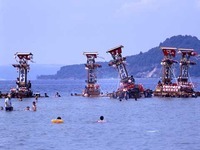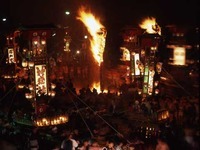

Total:35items
- Folk Performing Art (16)
- Kabuki (2)
- Noh & Kyogen (1)
- Festival (10)
- Wakubata woolen banner event of Kumakabuto Hatsuka Festival
- Hakone Feudal Lord's Procession Festival
- Uozu’s Tatemon Event
- Yama-age Event (Yama-age Festival)
- Yoshidanohimatsuri: Fire Festival of Yoshida
- Potato-comparing Festival in Nakayama, Oumi
- Noto's Kiriko Festival
- Ara-odori (Sankasho Shrine Festival)
- Mi-fune event in Kouchi Festival
- Nozawa Onsen Dosojin Festival
- Ritual & Ceremony (2)
- Puppet Play (2)
- Folk technology (2)

 |
|
 《Feature》
《Feature》Kiriko Festival is a general term, in which Kiriko accompanies Mikoshi or portable shrines, lighting streets, drifting and dancing boisterously, while protecting gods. Kiriko is an abbreviation of Kiriko Tourou or Kiriko lantern. In the area around Nakanoto, it is also known as Houtou or Oakashi.It is a very large festival lantern, which adds the festival in Noto area a special touch. The charactristic point of the Kiriko is that at night the Kiriko gather together at the shrine and once the departure ceremony is finished, the Kiriko and the portable shrines move together towards the Otabisho (God's place for a break) situated at the beach or riverbank. At the Otabisho the Hashira-taimatsu torches burning can be seen.
It is unknown whether the full-scale Kiriko Festival started in Noto or when it originally began to be used in summer or autumn festivals. Records concerning the shrine make hardly any mention of Kiriko. It may be the fact that the main carrier was committed to the townspeople, while the shrine parishioner only voluntarily carried Kiriko when they accompany the parade of portable shrine, therefore, few written records remained in the shrines.
The Kiriko seen in the Noto area are collectively referred to as Noto Kiriko, but actually the shape and ornaments differ respectively. Each district wants to feature their Kiriko the best in Noto (or in Japan) by being particular about the size, splendor, grace, majesty and maneuverability. Each competes with its own originality and attraction which are not seen in other district.
From early July until mid October, the Kiriko Festival takes place over hundreds of districts. Unfortunately, due to the decrease of the carrier, the number of Kiriko carried in the festival has been dropping each year. However, there are still left; 700 to 800, Kirikos still exist, including those in safekeeping.
Here are particularly lively festivals among many of Kiriko Festivals.
◆Abare Festival
Abare Festival is the first one which starts Kiriko Festival. It is designated by Ishikawa Prefecture as an Intangible Cultural Folk Asset.
The festival is held over two days. On the first day, 50 Kirikos dance boisterously around five taimatsu torches burning, bathed in sparks, which is a spectacular sight. On the second day, two Abare portable shrines are added to the Kiriko. These portable shrines are flung on the street many times and even dropped into the river with sparks. Finally, they are thrown into the fire of the taimatsu torches placed at Yasaka Shrine to the extent that their original forms are broken. "Abare" means to act violently, and as its name, it is an intently raging festival of a big impact.
The festival originates from the fact that long ago when a fierce epidemic erupted, this festival was held to pray for the appeasement.
◆Ishizaki Houtou Festival
The largest and most dynamic Kiriko in the Kiriko Festival is shown in this festival.
These large Houtous, which are 15 meters tall, 3 meters wide and 2 tons in weight, are carried by 100 men, wearing headbands, tabi and sarashi and holding amulets. Their way of controlling the Houtous is really magnificent. The festival takes place from dusk until night. When the Houtous are lighted, the pictures of warriors and characters in black ink emerge on the Houtou, which creates an atmosphere of fantasy.
It is known that the above special event started in the summer festival at Ishizaki Hachiman Shrine in the 22nd year of the Meiji era when a rope craftsman introduced an old Kiriko from Oku Noto.
◆Okinami Tairyou Festival
Okinami Tairyou Festival takes place in the daytime, under the blue sky.
It is held from morning until midday, while Kiriko Festival is in the evening, where as a highlight, the fantastic atmosphere is brought by lighting up the Kiriko, The festival continues over two days. On the first day, five Kirikos gather at the Ebisu temple and perform a boisterous dance. On the morning of the second day, they dance in the sea at Tattonohama, playing flutes, taiko and gongs.
The reason Kiriko is put into the water is for purifying; to bring the god of drifting ashore to the sea and purify it, then pray for a large catch of fish and safety on the sea.
Other than the festivals introduced here, there are many more festivals, included in Kiriko Festival.
This is a special annual event each year for the people of Noto. Even people who live away from the area return without fail for this event.
[National Selected Intangible Cultural Asset]
Provided by: Noto Travel Center
Reviewed by: Hiroko Okamura
| Location | Various places in the Noto peninsula
◆Abare Festival: Uchitzu, Noto-cho, Ishikawa Prefecture ◆Ishizaki Houtou Festival: Ishizaki-cho, Nano City, Ishikawa Prefecture ◆Okinami Tairyou Festival: Okinami area, Anamizumachi, Ishikawa Prefecture |
|---|---|
| Contact | Noto Travel Center
Tel 0768-26-2555 |
| Highlight/POI | ◆Abare Festival: The intensity of the festival can be seen very closely.
◆Ishizaki Houtou Festival: A fantastic and magnificent spectacle is unfolded with fireworks. ◆Okinami Tairyou Festival: The combination of the blue sky, sea, sand and the Kiriko is very beautiful. |
| General Participation | ◆Abare Festival: Uchitzu, Noto-cho, Ishikawa Prefecture: Every year, 1st Friday and Saturday of July
◆Ishizaki Houtou Festival: Ishizaki-cho, Nano City, Ishikawa Prefecture: Every year, 1st Friday and Saturday of August ◆Okinami Tairyou Festival: Okinami area, Anamizumachi, Ishikawa Prefecture: Every year, mid August Other festivals can be also viewed. |
| URL | http://www.notokiriko.jp/index.html |



